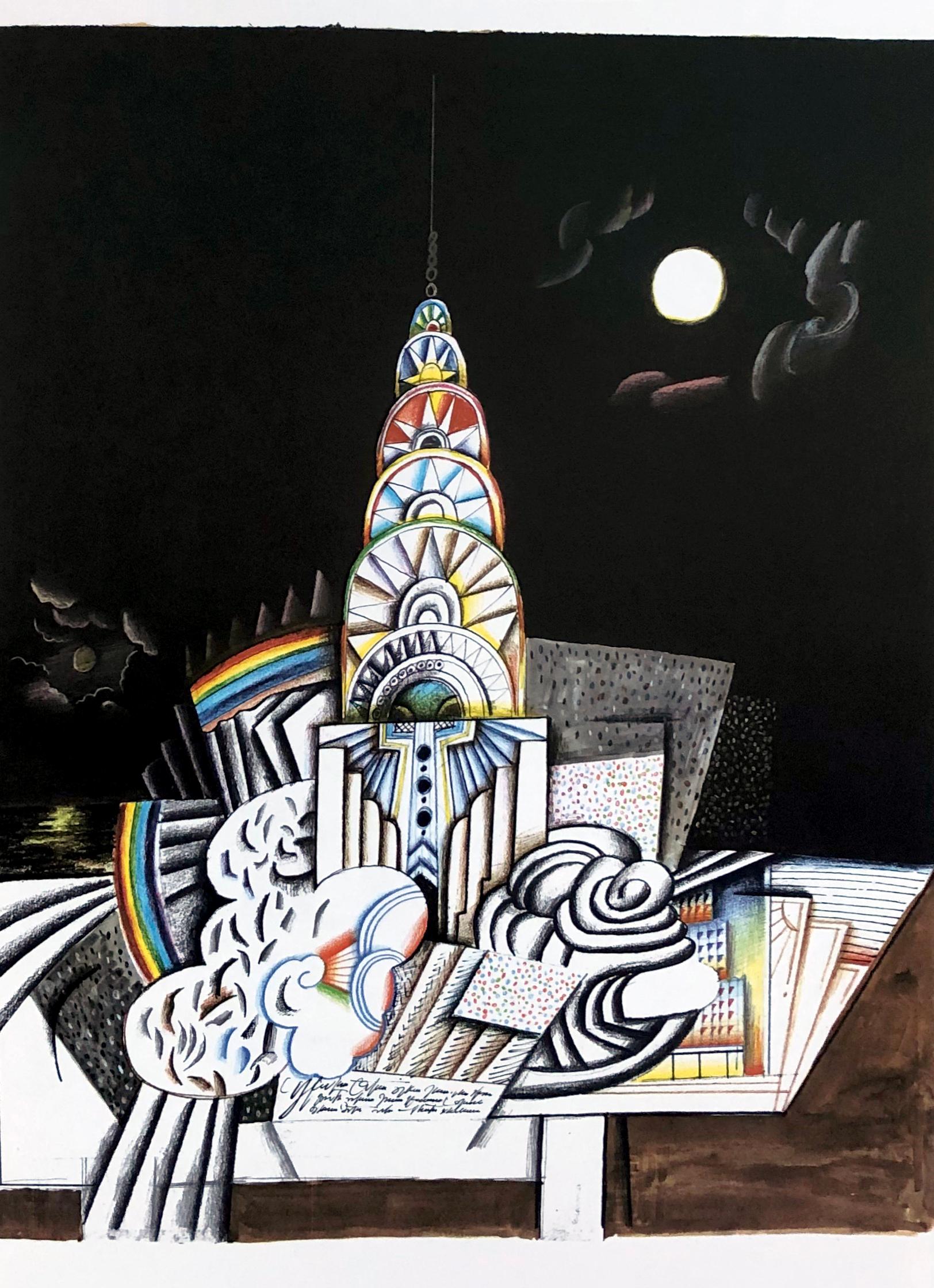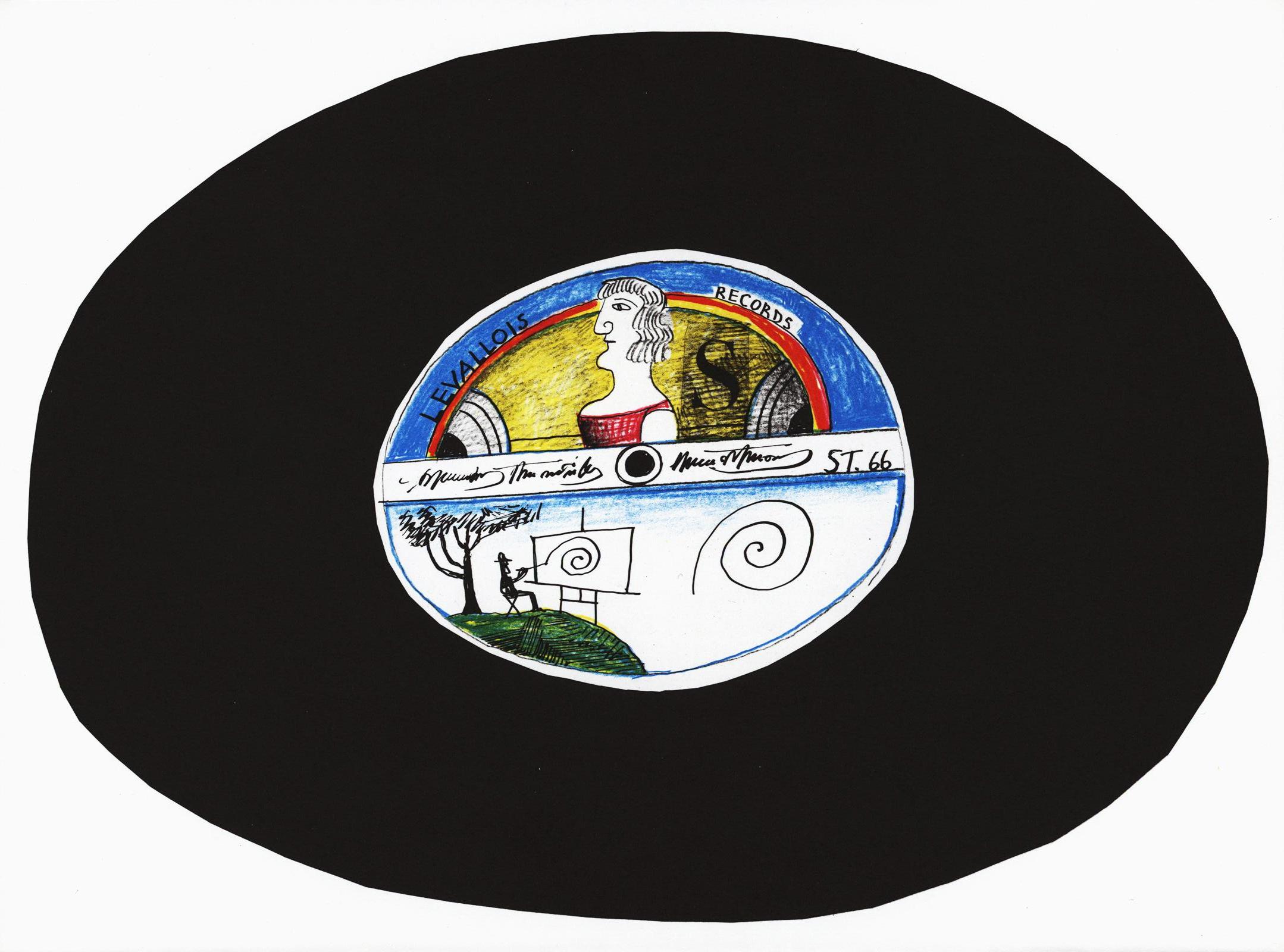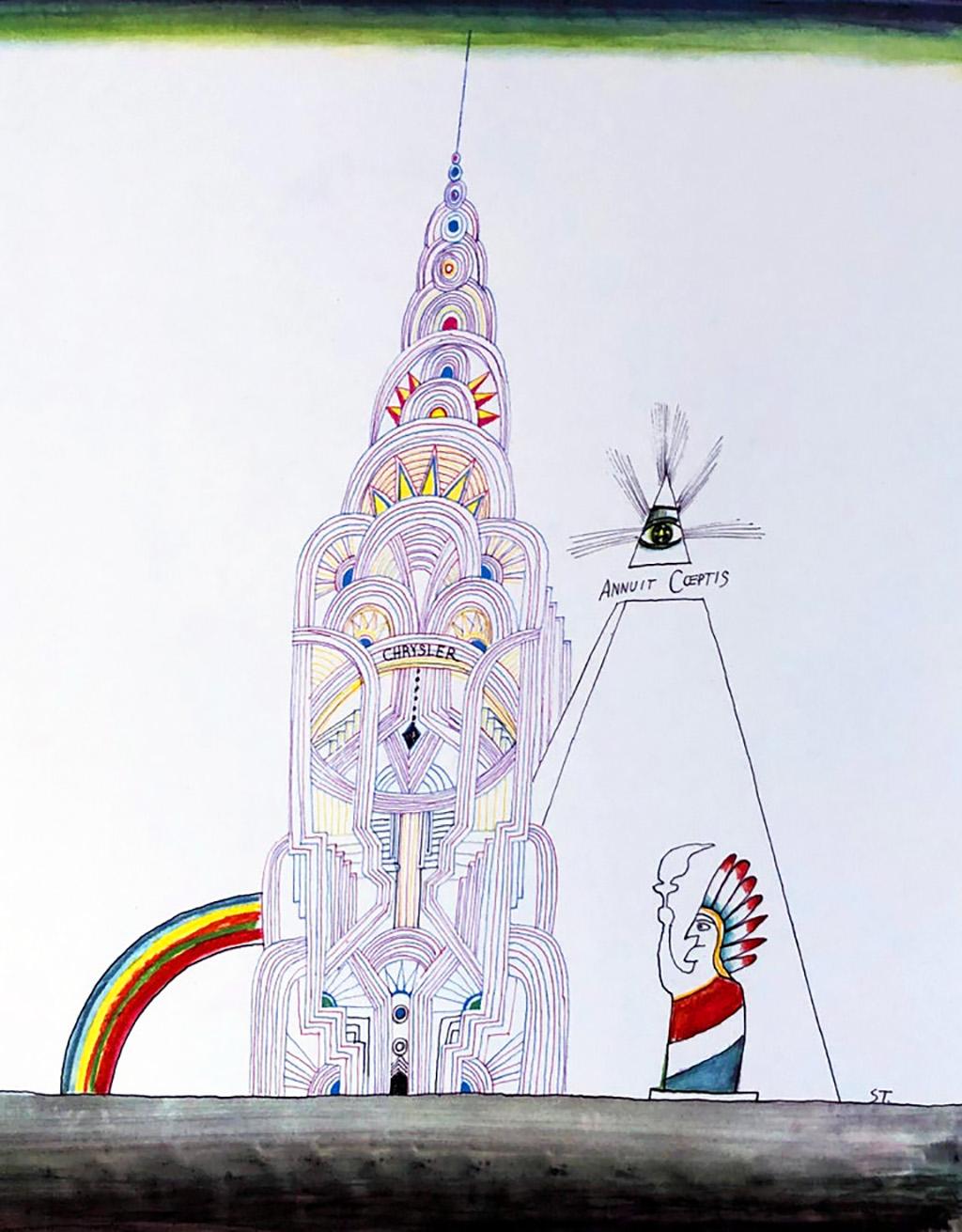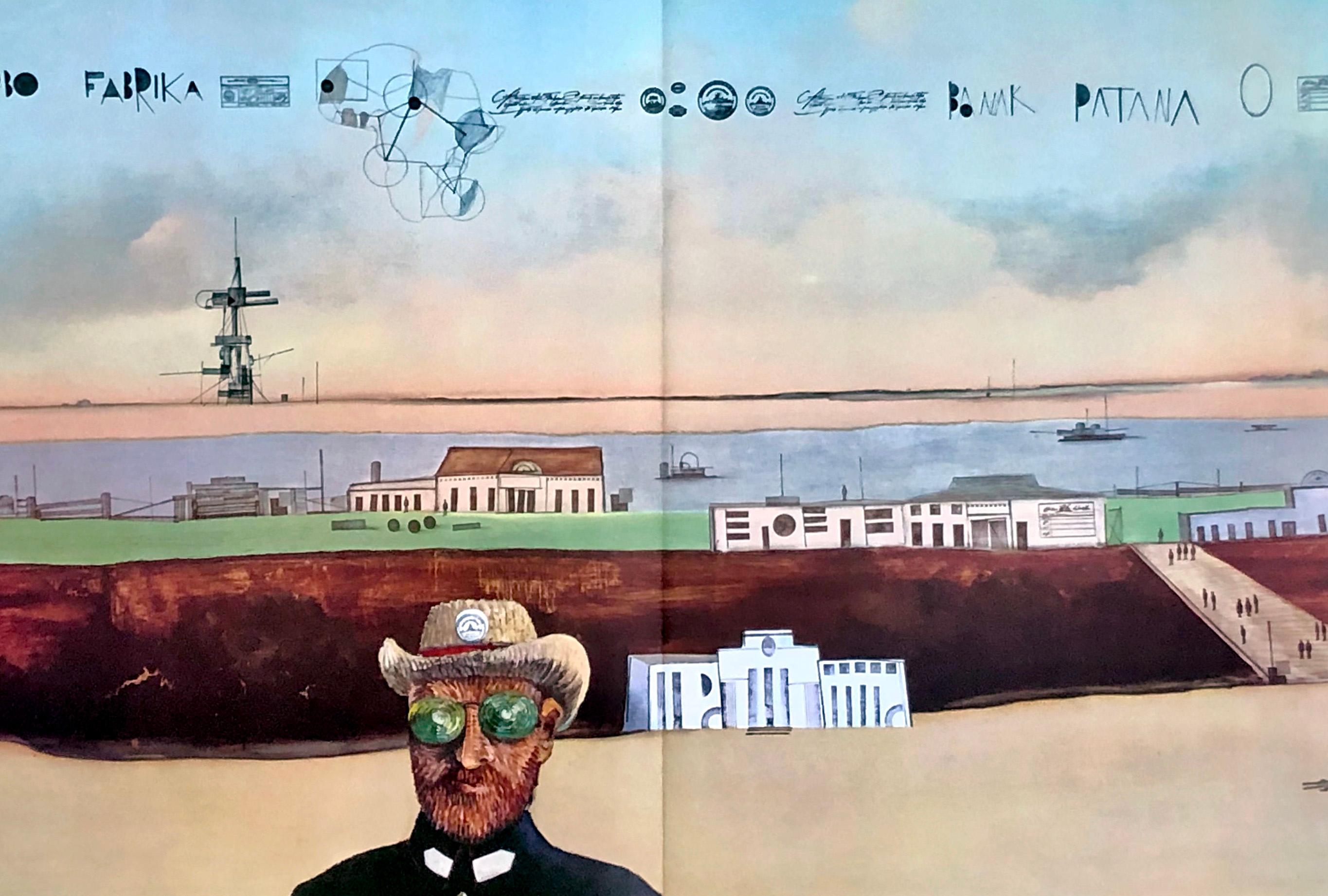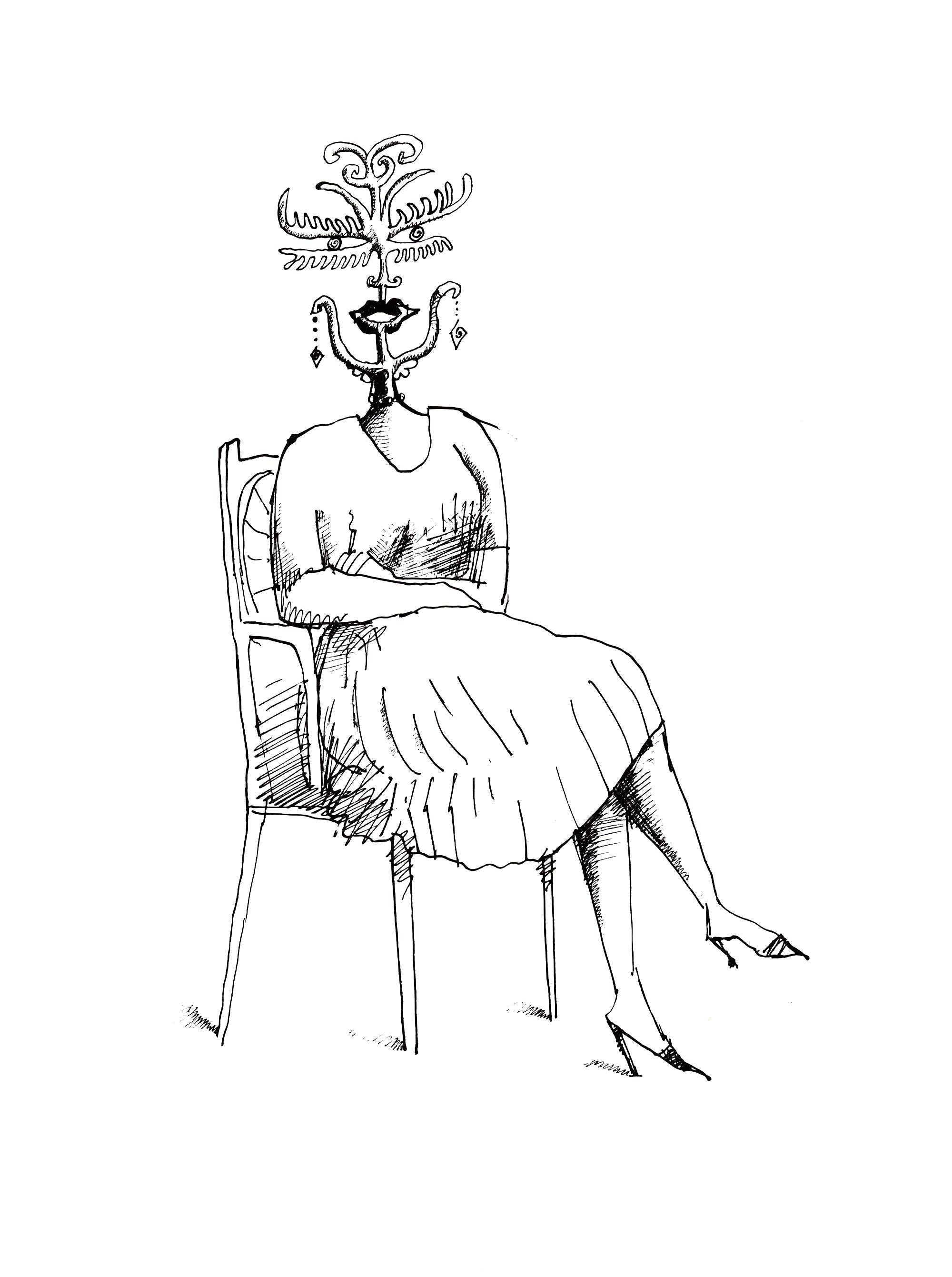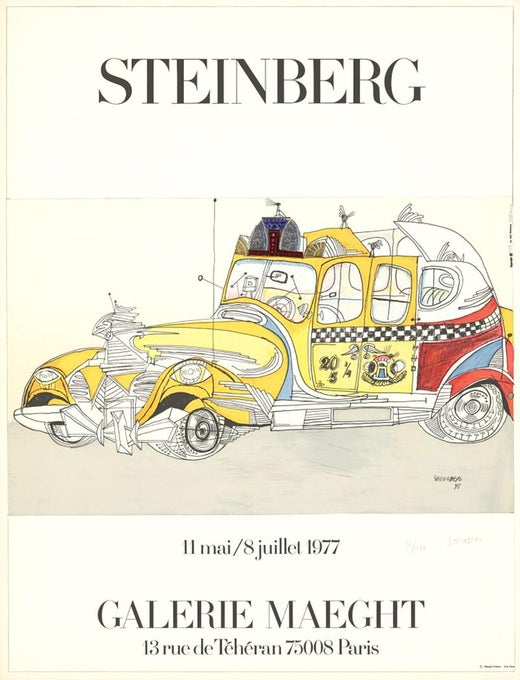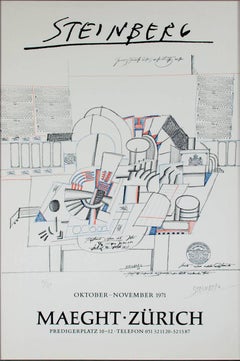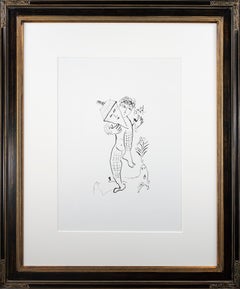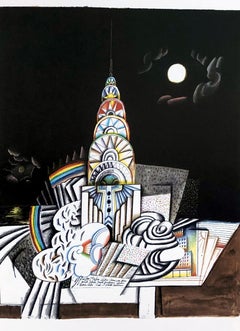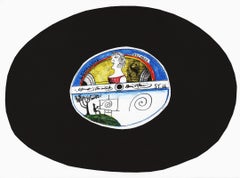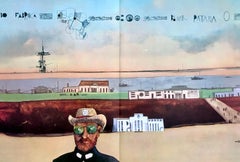Items Similar to "Derriere Le Miroir, " Three Original Color Lithographs by Saul Steinberg
Want more images or videos?
Request additional images or videos from the seller
1 of 7
Saul Steinberg"Derriere Le Miroir, " Three Original Color Lithographs by Saul Steinberg1977
1977
$10,900
£8,092.67
€9,430.19
CA$15,132.72
A$16,926.90
CHF 8,808.86
MX$208,375.90
NOK 112,066.93
SEK 105,140.87
DKK 70,358.61
Shipping
Retrieving quote...The 1stDibs Promise:
Authenticity Guarantee,
Money-Back Guarantee,
24-Hour Cancellation
About the Item
"Derriere Le Miroir" is an original color lithograph signed by the artist Saul Steinberg. The artist's signature is in the bottom left margin.
Image Size: 14"x20"
Frame Size: 25 5/8"x33 1/8"
From the Saul Steinberg Foundation: "Famed worldwide for giving graphic definition to the postwar age, Saul Steinberg (1914-1999) had one of the most remarkable careers in American art. While renowned for the covers and drawings that appeared in The New Yorker for nearly six decades, he was equally acclaimed for the drawings, paintings, prints, collages, and sculptures he exhibited internationally in galleries and museums.
Steinberg crafted a rich and ever-evolving idiom that found full expression through these parallel yet integrated careers. Such many-leveled art, however, resists conventional critical categories. “I don’t quite belong to the art, cartoon or magazine world, so the art world doesn’t quite know where to place me,” he said. 1 He was a modernist without portfolio, constantly crossing boundaries into uncharted visual territory. In subject matter and styles, he made no distinction between high and low art, which he freely conflated in an oeuvre that is stylistically diverse yet consistent in depth and visual imagination."
- Creator:Saul Steinberg (1914-1999, American)
- Creation Year:1977
- Dimensions:Height: 25.63 in (65.11 cm)Width: 33.13 in (84.16 cm)
- Medium:
- Movement & Style:
- Period:
- Framing:Frame IncludedFraming Options Available
- Condition:
- Gallery Location:Milwaukee, WI
- Reference Number:Seller: 928d1stDibs: LU60532210203
Saul Steinberg
Saul Steinberg was a Romanian American artist, best known for his work for The New Yorker, most notably View of the World from 9th Avenue. He described himself as "a writer who draws
About the Seller
4.9
Gold Seller
Premium sellers maintaining a 4.3+ rating and 24-hour response times
Established in 1966
1stDibs seller since 2017
434 sales on 1stDibs
Typical response time: 2 hours
- ShippingRetrieving quote...Shipping from: Milwaukee, WI
- Return Policy
Authenticity Guarantee
In the unlikely event there’s an issue with an item’s authenticity, contact us within 1 year for a full refund. DetailsMoney-Back Guarantee
If your item is not as described, is damaged in transit, or does not arrive, contact us within 7 days for a full refund. Details24-Hour Cancellation
You have a 24-hour grace period in which to reconsider your purchase, with no questions asked.Vetted Professional Sellers
Our world-class sellers must adhere to strict standards for service and quality, maintaining the integrity of our listings.Price-Match Guarantee
If you find that a seller listed the same item for a lower price elsewhere, we’ll match it.Trusted Global Delivery
Our best-in-class carrier network provides specialized shipping options worldwide, including custom delivery.More From This Seller
View AllDerriere Le Miroir
By Saul Steinberg
Located in Milwaukee, WI
"Derriere Le Miroir" is an original color lithograph created by the artist Saul Steinberg.
Edition: 53/150
Artwork Size: 14"x 20"
Frame Size: 33 1/8"x 25 5/8"
From the Saul Steinb...
Category
1970s Contemporary Figurative Prints
Materials
Ink, Lithograph
"Trompe L'Oeil, " Original Color Lithograph Abstract signed by Saul Steinberg
By Saul Steinberg
Located in Milwaukee, WI
"Trompe L'Oeil is an original color lithograph by Saul Steinberg. The artist signed the piece in the lower right and wrote the edition number (6/50) in the lower left. This piece sho...
Category
1970s Abstract Expressionist Abstract Prints
Materials
Lithograph
"Back Cover of Derrière le Miroir #235" Original Lithograph
By Marc Chagall
Located in Milwaukee, WI
"Back Cover of Derrière le Miroir #235, M 946" is an original lithograph by Marc Chagall. This Chagall is a graphic piece, with black lines on a white paper. The main figure is a je...
Category
1970s Surrealist Figurative Prints
Materials
Lithograph
Matisse Postcard Ed: 80/100 - Six Drawings Tables
By Saul Steinberg
Located in Milwaukee, WI
Art: 30-1/8 x 22-3/8 inches
Lithograph, from Portfolio
Signed and numbered ‘80’, from the edition of 100”
Famed worldwide for giving graphic definition to the postwar age, Saul Ste...
Category
1970s Abstract Drawings and Watercolors
Materials
Lithograph
"Derriere Le Miroir" Catalog with Five Lithographs
By Alexander Calder
Located in Milwaukee, WI
"Derriere Le Miroir" is a portfolio of lithographs by Alexander Calder. The artist signed the portfolio on the last page. This is edition number 146/150 of the deluxe edition, with t...
Category
1970s Modern Abstract Prints
Materials
Lithograph
"Musee National d'Art Moderne, " Framed Exhibition Poster by Victor Brauner
By Victor Brauner
Located in Milwaukee, WI
"Musee National d'Art Moderne" is a po ster by Victor Brauner for an exhibition of his work in Paris. It features abstracted heads in yellow, orange, and blue, with a border in pastel pink, green, blue, and yellow. It is framed with gold moulding.
33 1/2" x 19 5/8" art
40 1/2" x 26" frame
Victor Brauner was born in Piatra Neamt, in 1903, and died in Paris, in 1966. He was the son of a timber manufacturer from Piatra Neamt who settled in Vienna with his family for a few years. It is there that young Victor attended the elementary school. When his family returned to the country (1914), he continued his studies at the evangelical school in Braila; he began to be interested in zoology in that period.
He attended the Art School in Bucharest (1919-1921) and H. Igiroseanu’s private school of painting. He visited Falticeni and Balcic and started painting landscapes à la Cézanne. Then, as he testified himself, he went through all the stages: "Dadaist, Abstractionist, Expressionist".
On September 26, 1924, the Mozart Galleries in Bucharest hosted his first personal exhibition. In that period he met poet Ilarie Voronca, together with whom he founded the "15HP" magazine. It was in this magazine that Brauner published the manifesto "The pictopoetry" and the article "The surrationalism". He painted and exhibited "Christ at the Cabaret" (in the manner of Graosz) and "The Girl in the Factory" (in the manner of Holder). He participated to the "Contemporanul" exhibition (November 1924).
In 1925 he undertook his first journey to Paris, from where he returned in 1927. In the period 1928-1931 he was a contributor of the "Unu" magazine (an avant-garde periodical of Dadaist and Surrealist conceptions), which published reproductions of most of his paintings and graphic works: "clear drawings and portraits made by Victor Brauner to his friends, poets and writers" (Jaques Lessaigne - "Painters I Knew").
In 1930 he settled in Paris, where he met Brancusi, who initiated him into the photographic art. In that same period he became a friend of the Romanian poet Benjamin Fondane and met Yves Tanguil, who would later introduce him to the circle of the Surrealists. He lived on Moulin Vert St., in the same building as Giacometti and Tanguil. He painted "Self-portrait with a plucked eye", a premonitory theme.
In 1933, Andre Breton opened Brauner’s first personal exhibition in Paris, at the Pierre Gallery. The theme of the eye was omnipresent: "Mr. K’s power of concentration" and "The strange case of Mr. K" are paintings that Andre Breton compared with Alfred de Jarry’s play "Ubu Roi", "a huge, caricature-like satire of the bourgeoisie".
In 1935 he returned to Bucharest. He joined the ranks of the Communist Party for a short while, without a very firm conviction. On April 7, 1935, he opened a new personal exhibition at the Mozart Galleries. Sasa Pana wrote about it in his autobiographical novel "Born in 02": "April 7, 1935… An exhibition surrealist in character.
The catalogue shows 16 paintings; they are accompanied by verses, surrealist images that are exquisite by their bizarreness - they are perhaps the creations of automatic dictation and they certainly bear no connection to the painting itself. They are written in French, but their colorful taste remains in the Romanian translation too. The exhibition brought about many interesting articles and takings of position regarding Surrealism in arts and literature."
Another remark about Brauner’s participation to Surrealist exhibitions: "Despite its appearance of abstract formula,… this trend is a point a transition to the art that is to come." (R. Trost, in the"Rampa" of April 14, 1935) In the "Cuvantul liber" of April 20, 1935, Miron Paraschivescu wrote in the article "Victor Brauner’s exhibition": "In contrast to what one may see, for instance, in the neighboring exhibition halls, Victor Brauner’s painting means integration, an attitude that is a social one, as far as art allows it. For V. Brauner takes attitude through the very character and ideology of his art." On April 27, he created the illustrations for Gelu Naum’s poetry collection - "The Incendiary Traveler" and "The Freedom to Sleep on the Forehead".
In 1938 he returned to France. On August 28 he lost his left eye in a violent argument between Dominguez and Esteban Frances. Brauner attempted to protect Esteban and was hit by a glass thrown by Dominguez: the premonition became true.
That same year, he met Jaqueline Abraham, who was to become his wife. He created a series of paintings called "lycanthropic" or sometimes "chimeras".
He left Paris in 1940, together with Pierre Malbille. He lived for a while in Perpignan, at Robert Rius’, then at Cant-Blage (Eastern Pyrenees) and at Saint Feliu d’Amont, where he was forcibly secluded. However, he kept in touch with the Surrealists that had taken refuge in Marseille. In 1941, he was granted the permission to settle in Marseille. Seriously ill, he was hospitalized at the "Paradis" clinic.
He painted "Prelude to a civilization" (now in the Gelman collection). After the war, he took part to the Venice biannual exhibition; he traveled to Italy.
In 1959, he settled in the workshop on Lepic St. In 1961 he traveled to Italy again. He settled in Varengeville, where he spent most of his time working.
In 1965 he created an ensemble of object-paintings full of inventiveness and vivacity, grouped under the titles "Mythologie" and "Fêtes des mères...
Category
1970s Abstract Abstract Prints
Materials
Color
You May Also Like
Saul Steinberg lithograph derrière le miroir
By Saul Steinberg
Located in NEW YORK, NY
Saul Steinberg (untitled) Chrysler Building Lithograph from Derrière le miroir:
Lithograph in colors c.1970.
11 x 15 inches
Very good overall vintage condition.
Unsigned from an ed...
Category
1970s Pop Art Prints and Multiples
Materials
Lithograph
Saul Steinberg Lithograph c.1970 (from Derrière le miroir)
By Saul Steinberg
Located in NEW YORK, NY
Saul Steinberg Lithograph Derrière le Miroir:
Lithograph in colors c.1970.
11 x 14 inches.
Very good overall vintage condition with vivid colors.
Unsigned from an edition of unknown...
Category
1970s Pop Art Prints and Multiples
Materials
Lithograph
$200 Sale Price
20% Off
Saul Steinberg lithograph derrière le miroir
By Saul Steinberg
Located in NEW YORK, NY
Saul Steinberg Lithograph c. 1970 from Derrière le miroir:
Lithograph in colors; 15 x 11 inches.
Very good overall vintage condition; well-preseved.
Unsigned from an edition of...
Category
1970s Contemporary Figurative Prints
Materials
Lithograph
1970s Saul Steinberg lithograph (Steinberg Derrière le miroir)
By Saul Steinberg
Located in NEW YORK, NY
Vintage Saul Steinberg Lithograph c. 1970 from Derrière le miroir:
Medium & Dimensions: Lithograph in colors. 15 x 22 inches.
Condition: Fold-li...
Category
1970s Pop Art Figurative Prints
Materials
Lithograph
Saul Steinberg Lithograph c.1970 (from Derrière le miroir)
By Saul Steinberg
Located in NEW YORK, NY
Saul Steinberg Lithograph from Derrière le Miroir:
Lithograph in colors c.1970.
11 x 15 inches.
Very good overall vintage condition with vivid colors.
Unsigned from an edition of u...
Category
1970s Pop Art Prints and Multiples
Materials
Lithograph
Saul Steinberg lithograph 1970s (Saul Steinberg prints)
By Saul Steinberg
Located in NEW YORK, NY
Saul Steinberg Lithograph c. 1970 from Derrière le miroir:
Lithograph in colors; 15 x 22 inches. Very good overall vintage condition; center gold-line as originally issued.
...
Category
1970s Pop Art Figurative Prints
Materials
Lithograph

